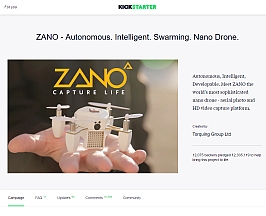Cover image by Maja Dumat, CC
Kickstarter and its crowdfunding peers are a futurist playground. They are filled with holograms, drones, robots and a whole host of other tech products previously thought out of reach. There have been some amazing success stories that have made crowdfunding one of the frontiers of consumer engagement – particularly in the gaming and entertainment sectors – but there have also been some spectacular failures.
Whether through unforeseen circumstances, negligence or outright fraud almost 10% of successfully funded projects don’t make it into the hands of their backers. Here are a few examples of technology crowdfunding gone wrong…
Community Cube
€93,438 pledged from 299 backers
This one is a personal hands in the air moment, as I recommended the campaign during one of the Kickstarter round-up lists posted here from time to time. Offering open source privacy and a way to make a stand against an ever-more encroaching global surveillance network, the Community Cube drew attention with its maverick attitude and cyberpunk design. I should have listened to my netsec friends who told me to steer clear, though, because unfortunately the project quickly stumbled when the team leader Jonay Sanz dropped out of the project abruptly and left his team to fend for themselves with little resources. To be fair to them, they have been keeping up with occasional updates (few and far between) and seem to be doing their best to at least deliver part of the initial promises. But two years later, with nothing yet to show for a sizeable investment, the Community Cube is an example of how team instability can often be the enemy of a good idea.
The Buccaneer™
$1,438,765 pledged from 3,520 backers
 This 3D printer for the everyday household was a huge crowdfunding success in 2013 that led to a viable and user-friendly product making a fully fledged retail debut. The problem was that it did this before the majority of pledges had been fulfilled, meaning that those who helped bring the product to market in the first place were hung out to dry. As one write-up has stated: “They produced an amazing product … The founders simply failed at building a viable company around [it].”
This 3D printer for the everyday household was a huge crowdfunding success in 2013 that led to a viable and user-friendly product making a fully fledged retail debut. The problem was that it did this before the majority of pledges had been fulfilled, meaning that those who helped bring the product to market in the first place were hung out to dry. As one write-up has stated: “They produced an amazing product … The founders simply failed at building a viable company around [it].”
Even now, many (most?) of the original backers have yet to receive their product or a regularly requested refund – all while they can see the product for sale on Amazon which just adds insult to injury.
Kreyos Meteor
$1,502,533 pledged from 11,717 backers
The $Million+ club of crowdfunding campaigns is an exclusive group, but unfortunately not one immune to failure. Indeed, sometimes the most successful campaigns can become overwhelmed by the task ahead of them and the obligations to thousands of backers who are quick to express their discontent when delays start setting in. The Kreyos Meteor smartwatch campaign on IndieGoGo is an example of the perfect storm where a lack of business-acumen, combined with the pressure of backer expectations, can quickly meet manufacturing problems (or shady practices, in this case) that ultimately end in project failure. With the Kreyos Meteor, a large number of backers eventually received their product – but it was nothing like what was promised and the quality level was rock bottom. Unlike many other failed projects, though, this one is particularly interesting because the CEO left behind a blow-by-blow account of what went wrong as a sincere form of apology. There are many lessons to be learned for both creators and backers alike in this rare show of transparency, but that’s little consolation to those who were burned by the campaign.
Katalyka
$7,840 pledged from 85 backers
Although not a tech product as such, I’m including this project because it combines science fiction elements with a kind of psycho-spiritual aesthetic that is both highly appealing and relevant to futurist utopian thinking. It is also a failed campaign that has become somewhat legendary within the crowdfunding community. A few months after a successful campaign that brought together a tight-knit group of backers, an update from its creator explained that the project was suffering setbacks because the Sun was telling her that she shouldn’t continue and risked releasing galactic secrets to an unprepared populace. This triggered conversations about whether this was some kind of in-character way to announce project delays, combined with other backers imploring that the creator seek psychiatric help immediately because they were suffering through a psychotic episode of some kind.
Mental health issues aren’t something to be flippant about, and the project seemed to continue on for at least a year following with plenty of progress made, but most of the backers are yet to see the product they had supported. Whilst it makes for a curious addition to a list of failed projects such as this, we can all only hope that the creator was able to find the help and support she needed to get through a difficult time.
Zano
£2,335,119 pledged from 12,075 backers
There are some campaigns where everything seems to go right. The team behind them has proven pedigree and experience; industry press is on board and promoting their efforts; Kickstarter themselves are keen to highlight their campaign; and after the success of the campaign they then increase the money raised by another 50% through pre-order channels. The Zano team had a clear roadmap, proven production channels and a vision that hit consumer interest perfectly. Who doesn’t want an autonomous drone that combines cutting-edge technology into a small form factor, affordable price all wrapped up in geek-chic cool. A bright future was ahead of them … but within months it had all come crashing down.
 Manufacturing problems, overly ambitious specifications and poor management once again combined to bring down what should have been a massively successful and market-changing product. There have been some excellent, detailed write-ups of what went wrong and they do ask the question everyone is thinking: if a project this successful can fail so spectacularly, what does that say about crowdfunding as a business model? It’s an important question to ask, because one of the main risks involved with crowdfunding – as we have seen from many of the projects listed here – is that great ideas often come from relatively inexperienced or over-extended teams.
Manufacturing problems, overly ambitious specifications and poor management once again combined to bring down what should have been a massively successful and market-changing product. There have been some excellent, detailed write-ups of what went wrong and they do ask the question everyone is thinking: if a project this successful can fail so spectacularly, what does that say about crowdfunding as a business model? It’s an important question to ask, because one of the main risks involved with crowdfunding – as we have seen from many of the projects listed here – is that great ideas often come from relatively inexperienced or over-extended teams.
Even those with sector experience, such as Torquing Group Ltd behind the Zano, can suffer the crisis that every business faces when it tries to step up in scale. The procedures and infrastructure needed to run a small sector-focused enterprise are very different to the ones needed to run a medium-sized business with international distribution of a complex product. It’s a known problem in general and the crowdfunding process often only serves to raise the stakes by demanding faster turnaround, much higher levels of public scrutiny and a tendency for business owners to get caught up in all the hype. Zano is a warning about the pitfalls of crowdfunding success – and one that should be carefully analysed by anyone with a great idea that they think is ready for primetime. It’s also a false-advertising line in the sand for backers, who are now demanding (as they should) a much more forthright and accurate depiction of product capabilities and potential.
Lily Camera Drone
In case you thought that crowdfunding failures might have been the result of teething problems with the business model, relegated to the past, the Lily Drone is here to shatter all expectations of how spectacularly a successfully-funded campaign can crash and burn. Another drone project that offered cutting-edge technology and automation, the final nail in the coffin came just last month when the creators announced that the project was folding due to the difficulty of securing additional rounds of funding and the production bottlenecks that resulted. All this after securing over $50,000,000 in pre-orders and VC funding.
At least all those who put money down have been offered a full refund – unlike many other failed campaigns. One of the differences with this campaign is that it wasn’t run through one of the usual crowdfunding platforms. Indeed, it has been criticised for being a kind of stealth campaign that misrepresented the extent to which the project was developed and viable through the advertisement of ‘pre-orders’. One drone blog even commented at the time that: “It’s already in the pre-order phase so that gives us hope that the project is in a bit more advanced stage, so less likely to be delayed for years.” Although the shittykickstarters sub-reddit quickly and correctly surmised that the project was a lame duck from the very beginning.
Ultimately, the Lily Drone is another example that highlights how complicated technology innovation projects really are. No matter how much money these campaigns raise, the risks are high and even when they do succeed at delivering it can often be a long and arduous wait for backers that can sometimes feel out-of-date by the time it finally arrives. All with a convincing note to self: don’t back crowdfunded drone projects…
Conclusion
This isn’t supposed to be a comprehensive list of failed Kickstarter campaigns or the downfalls of the crowdfunding business model, but even these few prominent examples highlight some serious cracks in the approach that is starting to massively undermine consumer trust and interest in these kind of shoot-for-the-stars technology campaigns. People will still put down money for ideas that might take years to come to fruition, if ever, but it does seem that we’ve reached a turning point where the market is becoming much more savvy and demanding a lot more from creators and the companies behind flashy campaigns that wow with innovative ideas but perhaps lack the business, production and distribution substance to follow through successfully.
Unfortunately, the risks surrounding crowdfunding might be most readily solved by established companies that have already proven themselves successful in the marketplace – which means that crowdfunding becomes more of a marketing tool than a pathway to seeing truly new and unique ideas emerge that might otherwise have never existed at all. It seems that amongst all the hype and the drama, the final risk is that we lose the soul of crowdfunding as it becomes just another tool in the corporate repertoire of consumer persuasion. Perhaps to say that is to overlook all the great successes that have emerged through the model, though – but we’ll get to that next time…





